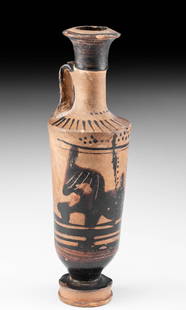
Greek Apulian Red-Figure Lekythos w/ Dancer
Similar Sale History
View More Items in PaintingsRelated Paintings
More Items in Paintings
View MoreRecommended Art
View More





Item Details
Description
Magna Graecia, South Italic Colonies, Apulia, ca. 340 to 325 BCE. A wheel-thrown lekythos with an egg-shaped body atop a grooved discoid base, a rounded shoulder which tapers to a corseted cylindrical neck, a flared and in-folded rim, and a high-arching handle joining neck and shoulder. The black-glazed exterior boasts areas of red-figure artistry, including a dancing woman dressed in a long, flowing robe as she holds a mirror between 2 vertical vegetal motif borders and above a band of a repeated tongues. Size: 2" in diameter x 5.375" H (5.1 cm x 13.7 cm)
Lekythoi were used for storing oil used for a wide variety of purposes in the Classical World. While larger examples were usually designated for keeping olive oil, smaller more delicate examples were reserved for the bath to store precious unguents of sweet and floral aromas. Given the tall aspect of this piece, it was likely used to store olive oil for special gatherings.
Perhaps the most exciting innovation in Greek vase painting was the red-figure technique, invented in Athens around 525 BCE and beloved by other artists of Magna Graecia. The red-figure technique allowed for much greater flexibility as opposed to the black-figure technique, for now the artist could use a soft, pliable brush rather than a rigid metal graver to delineate interior details, play with the thickness of the lines, as well as build up or dilute glazes to create chromatic effects. The painter would create figures by outlining them in the natural red of the vase, and then enrich these figural forms with black pigment to suggest volume, details, at times perspectival depth, and movement, bringing those silhouettes and their environs to life. Beyond this, fugitive pigments made it possible for the artist to create additional layers of interest and detail as we see in this example.
Provenance: private J. P. collection, Rye, Colorado, USA; ex-Bill Buffinger collection, Hollywood, California, USA, acquired July 20, 1999; ex-Pegasi Numismatics, Ann Arbor, Michigan, USA
All items legal to buy/sell under U.S. Statute covering cultural patrimony Code 2600, CHAPTER 14, and are guaranteed to be as described or your money back.
A Certificate of Authenticity will accompany all winning bids.
PLEASE NOTE: Due to recent increases of shipments being seized by Australian & German customs (even for items with pre-UNESCO provenance), we will no longer ship most antiquities and ancient Chinese art to Australia & Germany. For categories of items that are acceptable to ship to Australia or Germany, please contact us directly or work with your local customs brokerage firm.
Display stands not described as included/custom in the item description are for photography purposes only and will not be included with the item upon shipping.
#166172
Lekythoi were used for storing oil used for a wide variety of purposes in the Classical World. While larger examples were usually designated for keeping olive oil, smaller more delicate examples were reserved for the bath to store precious unguents of sweet and floral aromas. Given the tall aspect of this piece, it was likely used to store olive oil for special gatherings.
Perhaps the most exciting innovation in Greek vase painting was the red-figure technique, invented in Athens around 525 BCE and beloved by other artists of Magna Graecia. The red-figure technique allowed for much greater flexibility as opposed to the black-figure technique, for now the artist could use a soft, pliable brush rather than a rigid metal graver to delineate interior details, play with the thickness of the lines, as well as build up or dilute glazes to create chromatic effects. The painter would create figures by outlining them in the natural red of the vase, and then enrich these figural forms with black pigment to suggest volume, details, at times perspectival depth, and movement, bringing those silhouettes and their environs to life. Beyond this, fugitive pigments made it possible for the artist to create additional layers of interest and detail as we see in this example.
Provenance: private J. P. collection, Rye, Colorado, USA; ex-Bill Buffinger collection, Hollywood, California, USA, acquired July 20, 1999; ex-Pegasi Numismatics, Ann Arbor, Michigan, USA
All items legal to buy/sell under U.S. Statute covering cultural patrimony Code 2600, CHAPTER 14, and are guaranteed to be as described or your money back.
A Certificate of Authenticity will accompany all winning bids.
PLEASE NOTE: Due to recent increases of shipments being seized by Australian & German customs (even for items with pre-UNESCO provenance), we will no longer ship most antiquities and ancient Chinese art to Australia & Germany. For categories of items that are acceptable to ship to Australia or Germany, please contact us directly or work with your local customs brokerage firm.
Display stands not described as included/custom in the item description are for photography purposes only and will not be included with the item upon shipping.
#166172
Condition
Repair to neck with break line visible. Light chips to base and minor nicks and abrasions throughout, commensurate with age. Possible repainting to areas. Otherwise, excellent with impressive pigments.
Buyer's Premium
- 24.5%
Greek Apulian Red-Figure Lekythos w/ Dancer
Estimate $800 - $1,200
24 bidders are watching this item.
Shipping & Pickup Options
Item located in Louisville, CO, usOffers In-House Shipping
Local Pickup Available
Payment

Related Searches
TOP









































































